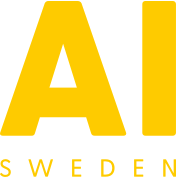AI Vision
AI Sweden and partners Centiro, Region Gävleborg, Sahlgrenska University Hospital, the Swedish Tax Agency, Västra Götalandsregionen, Zenseact and Östgötatrafiken have developed a AI Vision White Paper. Download a guiding white paper and a template to help your organization set their AI vision faster and with better results.

An AI vision sets the direction for working with AI. Organizations that are increasing their focus on AI can benefit from getting aligned behind a vision that creates a better understanding of AI and its place in the organization. Without a vision, organizations risk putting too little focus on the most valuable projects, or worse; spending resources on the wrong ones. In a recent report, McKinsey found that companies that see the highest return on investment from AI are much more likely to have a clearly defined AI vision and strategy. However, developing an AI vision can be complicated and achieving the intended impact can be hard. Not much guidance has so far been produced on what goes into an AI vision and there have been few best practice references.
The white paper is a guide developed to help organizations create their AI vision faster and with better results. This practical tool is the product of AI Swedens and the collaborating partners' combined experiences. It explains what an AI vision is, the process of creating it and how to communicate it. In addition to the white paper, an easy-to-use template accompanies it.
Who can benefit from using the white paper?
Private or public, any organization that wants to work more with AI could benefit from it. Ideally, an AI vision is developed after the organization has developed its first experiments or proof of concepts. The AI vision serves as a roadmap for further scaling.
Why did we create the AI Vision White Paper?
“We wanted to create this white paper because it is something all of us would have loved to have access to when we first started working on setting an AI strategy. By getting this paper out, the hope is to help other organizations speed up their process and bring clarity,” says Lucas Ambjörn, Expert in Digitization and AI Transformation at Zenseact, one of the contributors to the whitepaper.
Another contributor, Cecilia Hahn Berg, Strategist for Life Science at Sahlgrenska University Hospital also shares her view on how the paper could benefit organizations:
“Spending 30 minutes reading through the white paper will hopefully pay back in at least two ways. Firstly, to speed up the process of deciding if an AI vision will benefit your organization at all. Second, the white paper will help you understand how to set up the process to create an AI vision.”
Collaborating across sectors
The AI Vision White Paper was developed by a broad combination of organizations, ranging from public to private and from large to medium-sized. The work was done in a series of workshops spanning over three months. “We could build in all our knowledge in the paper from different companies and authorities,” says Anders Fryden, AI coordinator and Change Manager at the Swedish Tax Agency. Cecilia Hahn Berg added that “the wide-ranging perspectives hopefully result in a white paper that is applicable to a broader audience.”
During the workshops, the group gathered knowledge and inspiration from other sources as well as sharing their own experiences.
The AI Vision White Paper is available in both English and Swedish.
AI Vision White Paper and template in English
AI Vision White Paper och mall på svenska
For more information, contact


